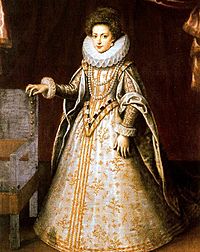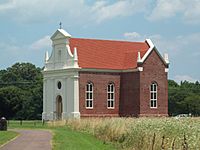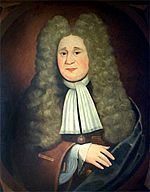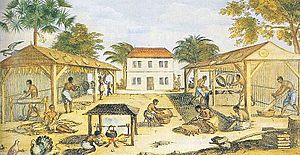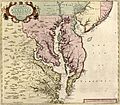Province of Maryland facts for kids
Quick facts for kids
Province of Maryland
|
|||||||||
|---|---|---|---|---|---|---|---|---|---|
| 1632–1776 | |||||||||
|
|
|||||||||
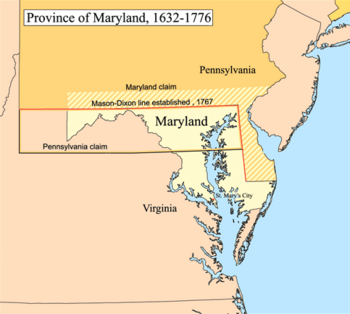
Map of the Province of Maryland
|
|||||||||
| Status | Colony of England (1632–1707) Colony of Great Britain (1707–1776) |
||||||||
| Capital | St. Mary's City (1632–1695) Annapolis (from 1695) |
||||||||
| Common languages | English, Susquehannock, Nanticoke, Piscataway | ||||||||
| Religion | Anglicanism (de jure), Roman Catholicism (de facto) | ||||||||
| Government | Constitutional monarchy | ||||||||
| Royally Chartered Proprietor | |||||||||
|
• 1632–1675
|
Lord Baltimore, 2nd | ||||||||
|
• 1751–1776
|
Lord Baltimore, 6th | ||||||||
| Proprietary Governor | |||||||||
|
• 1634–1647
|
Leonard Calvert | ||||||||
|
• 1769–1776
|
Robert Eden | ||||||||
| Legislature | Maryland General Assembly | ||||||||
| History | |||||||||
|
• Charter granted
|
1632 | ||||||||
| July 4 1776 | |||||||||
| Currency | Maryland pound | ||||||||
|
|||||||||
| Today part of | United States | ||||||||
The Province of Maryland was an English, and later British, colony in North America. It existed from 1632 until 1778. In 1778, it joined the other twelve colonies in a fight against Great Britain. This fight was called the American Revolution. After the Revolution, Maryland became the U.S. state of Maryland.
The first settlement and capital of the province was St. Mary's City. This city was located on a peninsula in the Chesapeake Bay. It was also surrounded by four tidal rivers.
The colony started as a special type of colony called a proprietary colony. This meant it was owned by an English nobleman, Lord Baltimore. He wanted to create a safe place for English Catholics in the New World. At that time, Europe was experiencing many religious wars.
Maryland was one of the first English colonies to allow different religions. However, there was still a lot of religious conflict. Anglicans, Puritans, Catholics, and Quakers often disagreed. Puritan rebels even took control of the province for a short time. In 1689, a rebellion led by John Coode removed Lord Baltimore, who was Catholic, from power. The Baltimore family got control back in 1715. This happened when Charles Calvert, 5th Baron Baltimore publicly stated he was a Protestant.
Maryland was similar to the colony of Virginia to its south. Its early towns grew along rivers and waterways leading to the Chesapeake Bay. Like Virginia, Maryland's economy quickly focused on growing tobacco. Tobacco was sold in Europe. To get enough workers, the colony used indentured servitude. This meant people worked for a set time to pay for their travel. They also used penal transportation, which sent criminals to the colony. Sadly, they also forced Africans into slavery.
The Province of Maryland played an important role in the events leading to the American Revolution. Maryland citizens signed the Declaration of Independence in 1776. This ended British rule in the colony.
Contents
How Maryland Began in the 1600s
The First Plan for Maryland
George Calvert, 1st Baron Baltimore, a Catholic, wanted to create a safe place for English Catholics in the New World. He had been a high-ranking official for King Charles I. He had already tried to start a colony in Newfoundland, Canada, called "Avalon." He then asked the King for land further south.
In 1632, George Calvert died. The King then gave the land grant to his oldest son, Cecil. On June 20, 1632, King Charles I officially granted the charter for Maryland. This was a "proprietary colony," meaning it was owned by the Calvert family. It was about 12 million acres (49,000 km²).
The new colony was named after Henrietta Maria of France. She was the Queen and a devout Catholic. Maryland was much larger than the state of Maryland is today. The original plan gave the Calverts land north of Virginia and south of the 40th parallel.
First Settlers Arrive
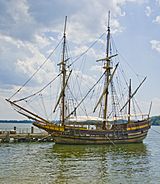
Cecil Calvert, Lord Baltimore, wanted Maryland to be a place where Catholics and Protestants could live together peacefully. He even created a law about religious tolerance. This was a big deal because being Catholic in England at that time could be dangerous. Lord Baltimore also hoped to make money from the new colony.
The Calvert family invited both Catholic and Protestant settlers to Maryland. They offered large land grants and promised religious freedom. To attract more people, Maryland used the "headright system." This system gave settlers 50 acres of land for each person they brought to the colony. This included family members, indentured servants, or slaves.
About 200 settlers came to Maryland on two ships, the Ark and the Dove. Most of these first settlers were Protestant. On November 22, 1633, Lord Baltimore sent them off. After a long journey, the ships landed on March 25, 1634. This day is now celebrated as "Maryland Day." They landed at St. Clement's Island.
The settlers were led by Lord Baltimore's younger brother, Leonard Calvert. He was chosen to be the governor of the new colony. On St. Clement's Island, they put up a large cross and held a religious service. Their first permanent town was called "St. Mary's City." This became Maryland's first capital. It remained the capital for 60 years until 1695. Then, the capital moved north to a new town called "Annapolis."
More settlers soon arrived. The tobacco crops they planted were very successful. This made the new colony profitable quickly. However, diseases like malaria and typhoid were common. Life expectancy in Maryland was about 10 years shorter than in New England.
Today, "Historic St. Mary's City" works to protect the remains of the original 17th-century village. They have also rebuilt some historic buildings. The colony stayed under the control of the Calvert family until 1775–1776. Then, it joined other colonies in the American Revolution and became the independent U.S. State of Maryland.
Maryland's Relationship with Native Americans
In 1642, Maryland declared war on the Susquehannock Indian nation. The Susquehannock, with help from the Swedish colony of New Sweden, defeated Maryland in 1644. This meant the Susquehannock mostly traded with New Sweden.
Maryland and the Susquehannock made a peace treaty in 1652. The Susquehannock gave Maryland large areas of land around the Chesapeake Bay. In return, Maryland gave them weapons and protection. This was important because of conflicts with the Haudenosaunee (Iroquois) tribes. With Maryland's help, the Susquehannock fought off the Iroquois.
However, the Susquehannock nation was later weakened by disease. By the 1670s, their population was very small. In a later peace treaty, the Iroquois agreed to take in the remaining Susquehannock people.
Disputes Over Borders
Fighting Over Land with Virginia
In 1629, George Calvert, 1st Baron Baltimore wanted to create a colony south of Virginia. He also hoped to make money from tobacco, like Virginia was doing. In 1631, a Puritan from Virginia named William Claiborne received permission to trade with Native Americans. He set up a trading post on Kent Island in May 1631.
When Cecil Calvert received the Maryland charter in 1632, Kent Island was on his new land. Claiborne refused to accept Lord Baltimore's ownership. This led to conflicts between the two colonies.
The Border with Pennsylvania
Maryland also had a long-running border dispute with Pennsylvania. This led to a conflict called Cresap's War in the 1730s. Settlers from both colonies fought over land and legal rights. The fighting became serious, with military forces involved. In 1738, King George II stepped in and ordered a cease-fire.
Maryland lost some land to Pennsylvania in the 1760s. King Charles II had given the Penn family, who owned Pennsylvania, land that overlapped with Maryland's grant. For 80 years, the Penn and Calvert families argued over these overlapping claims. In 1767, surveyors Charles Mason and Jeremiah Dixon mapped the border. This created the famous Mason–Dixon line.
Religious Conflicts in the Colony
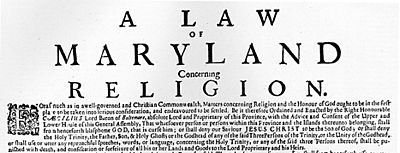
Even though Maryland was one of the first colonies to allow different religions, there was often conflict. Anglicans, Puritans, Roman Catholics, and Quakers often disagreed. Puritan rebels even took control of the province for a short time.
In 1644, the dispute with William Claiborne led to fighting. Claiborne took over Kent Island. His friend, Richard Ingle, took over St. Mary's. Both used religion to get support. From 1644 to 1646, there was a period of unrest called the "Plundering Time." This was made worse by the English Civil War happening in England. Leonard Calvert returned with troops and restored order.
In 1649, Maryland passed the Maryland Toleration Act. This law said that all Christians who believed in the Trinity (God as Father, Son, and Holy Spirit) should be tolerated. It was the first law of its kind in the English colonies in North America. However, in 1654, after another English Civil War, Puritan forces took control of Maryland for a while.
Lord Baltimore noted that Maryland had many different Christian groups. He said it would be very hard to make them all agree to support ministers of a different faith.
The Protestant Revolution of 1689
By 1689, Puritans were the majority in Maryland. They rebelled against the "proprietary government" because Catholics seemed to be favored for powerful positions. Colonel John Coode led an army of 700 Puritans. They defeated the proprietary army led by Colonel Henry Darnall. Darnall later wrote that they surrendered to avoid more bloodshed.
Coode and his Puritans set up a new government that outlawed Catholicism. Darnall lost all his official roles. However, Coode's government was not very popular. In 1692, King William III appointed a new governor, Lionel Copley.
After this "Protestant Revolution," Catholics like Darnall had to practice their faith in secret. In 1704, a law was passed to "prevent the growth of Popery." This law stopped Catholics from holding political office. Full religious tolerance did not return to Maryland until the American Revolution. At that time, Darnall's great-grandson, Charles Carroll of Carrollton, signed the American Declaration of Independence.
Farms and the Economy
| Historical population | ||
|---|---|---|
| Year | Pop. | ±% |
| 1640 | 583 | — |
| 1650 | 4,504 | +672.6% |
| 1660 | 8,426 | +87.1% |
| 1670 | 13,226 | +57.0% |
| 1680 | 17,904 | +35.4% |
| 1690 | 24,024 | +34.2% |
| 1700 | 29,604 | +23.2% |
| 1710 | 42,741 | +44.4% |
| 1720 | 66,133 | +54.7% |
| 1730 | 91,113 | +37.8% |
| 1740 | 116,093 | +27.4% |
| 1750 | 141,073 | +21.5% |
| 1760 | 162,267 | +15.0% |
| 1770 | 202,599 | +24.9% |
| 1780 | 245,474 | +21.2% |
| Source: 1640–1760; 1770–1780 | ||
Early towns and populations in Maryland grew near rivers and waterways that flowed into the Chesapeake Bay. In the 1600s, most Marylanders lived simply on small farms. They grew fruits, vegetables, grains, and raised animals. But their main crop was tobacco, which quickly became the most important part of the colony's economy.
Maryland's economy was very similar to Virginia's. Tobacco was even used as money. The colonial government had to make a law that tobacco farmers also had to grow a certain amount of corn. This was to make sure people had enough food. The need for cheap labor to grow tobacco led to a rapid increase in indentured servitude. Later, it led to the forced immigration and enslavement of Africans.
By 1730, there were public tobacco warehouses every fourteen miles. Ships from England would sail directly to these warehouses or plantations along the rivers. They would pick up tobacco and return the next year with goods that the planters had ordered.
Many independent farmers also lived outside the large plantations. They rented land or owned it. They focused on growing food for their families. Many Irish and Scottish immigrants made rye-whiskey to earn cash.
Maryland in the 1700s
By the 1700s, Maryland had become a plantation colony. In 1700, there were about 25,000 people. By 1750, this number had grown to 130,000. By 1755, about 40% of Maryland's population was Black. Maryland planters also used many indentured servants and people sent there as punishment.
A network of rivers helped move farm products from inland areas to the Atlantic coast for export. Baltimore, located on Chesapeake Bay, became the second most important port in the southern colonies. Only Charleston, South Carolina, was busier.
Dr. Alexander Hamilton was a Scottish doctor who lived in Annapolis. His travel diary from 1744, Gentleman's Progress, gives a great look at life in colonial America.
As the American Revolution got closer, the southern and eastern parts of Maryland continued to grow tobacco. But in northern and central Maryland, farmers started growing more wheat. This helped towns like Frederick and the port city of Baltimore grow.
A French chaplain, Abbé Claude C. Robin, visited Maryland during the Revolutionary War. He described the wealthy families' lives: Their homes were large and spacious, surrounded by huge farms. These farms were worked by "unhappy black men whom European greed brings hither." Their furniture was made of expensive wood and marble. They had elegant carriages pulled by fine horses and driven by enslaved people.
Maryland and the American Revolution
Up until the American Revolution, the Province of Maryland was one of only two colonies that were still "proprietary colonies." The other was Pennsylvania. Maryland declared independence from Britain in 1776. Samuel Chase, William Paca, Thomas Stone, and Charles Carroll of Carrollton signed the Declaration of Independence for Maryland.
In the debates about the Articles of Confederation (the first government of the United States), Maryland insisted that states with western land claims give them up. In 1781, Maryland was the last state to approve the Articles of Confederation. It accepted the United States Constitution more easily, approving it on April 28, 1788. Maryland also gave up some land to create the new District of Columbia after the American Revolution.
Images for kids
See also
 In Spanish: Provincia de Maryland para niños
In Spanish: Provincia de Maryland para niños




